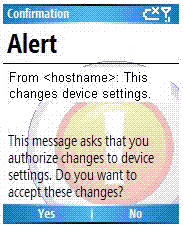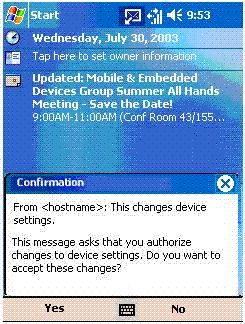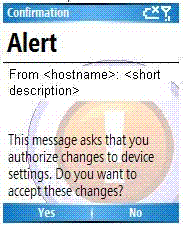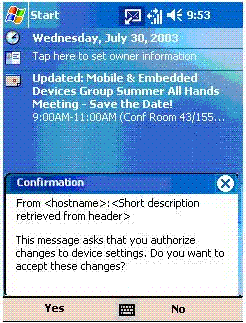 Important: Important: |
|---|
| This is retired content. This content is outdated and is no longer being maintained. It is provided as a courtesy for individuals who are still using these technologies. This content may contain URLs that were valid when originally published, but now link to sites or pages that no longer exist. |
A user can prompt for network PIN device management messages as per the WAP specification. This is necessary in some cases where the mobile operator is required to prompt the user before implementing a remote configuration request on the device. In these cases, a device management server creates a WAP provisioning message, signs it with the network PIN, and sends to the device over SMS channel. The user is then prompted by a confirmation dialog on the device which prompts the user to accept or reject the device configuration request from the mobile operator. The configuration request is processed by the device only if the user accepts the request. A new message in the Inbox will inform the user of the status of the configuration success or failure.
Note that this user prompt appears only if the message is signed with a pure network PIN and not if it is signed with user PIN only or user PIN and network PIN.
The following table shows the user prompt, for Windows Mobile Standard, Windows Mobile Professional and Windows Mobile Classic.
| Device | User Prompt |
|---|---|
|
Windows Mobile Standard |

|
|
Windows Mobile Professional and Windows Mobile Classic |

|
Note that the text "This message asks that you authorize changes to device settings. Do you want to accept these changes?" is predefined and cannot be customized.
 Customization of the User
Prompt
Customization of the User
Prompt
Customization of the text in the <hostname> and <Short description retrieved from header> fields in the user prompt is possible using the information in the Over The Air (OTA) provisioning message headers, as shown in the following table.
| Device | User Prompt |
|---|---|
|
Windows Mobile Standard |

|
|
Windows Mobile Professional and Windows Mobile Classic |

|
The text in <hostname> and <Short description retrieved from header> is retrieved from the OTA Provisioning message headers.
- <hostname>
-
The value of X-WAP-Initiator-URI header. If X-Wap-Content-URI is present, its value is considered as the default value for X-Wap-Initiator-URI. If X-Wap-Content-URI is not present, the default value of X-Wap-Initiator-URI is considered to be the same as the value of Content-Location, if present. If none of these headers exist, it means <hostname> isn't available. In this case, the default string <unidentified sender> is used in <hostname>.
- <Short description retrieved from header>
-
Contains content provided by the X-MS-DESC header. X-MS-DESC is a Microsoft custom header designed to allow the server to put in a short description of the content of an OTA provisioning message.
Note The maximum length of the content of an X-MS-DESC header that can be shown in the user prompt on a Windows Mobile Professional and Windows Mobile Classic device is 70 characters. In addition, the maximum length of <hostname> that can be shown in the user prompt is 40 characters.







 See Also
See Also